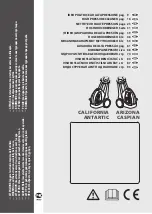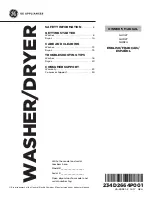
10
PRODUCT DATA SHEETS IN ACCORDANCE WITH EU 1061/2010 DIRECTIVE ON ENERGY LABELLING
Type
Capacity
kg
Energy
Class
(1)
Consumption data - Standard Programma (5)
Annual energy
consumption
(2) kWh
Cotton 60°C
full load
kWh
Cotton 60°C
Half load
kWh
Cotton 40°C
half load
kWh
Stand by
OFF W
Stand by
ON W
Annual water
consumption
(3) L
Water
consumption/
cycle 40°C half
load L
WISL1050
5
A++
142
0,7
0,7
0,4
0,08
0,35
6380
24,4
WISD1460
6
A+++
150
0,8
0,8
0,4
0,08
0,35
7700
28,7
WIL1070
7
A+++
169
0,8
0,8
0,5
0,08
0,35
8140
32,4
WID1480
8
A+++
193
0,9
0,9
0,5
0,08
0,35
8800
33,9
WID1290
9
A+++
209
1,1
1,0
0,6
0,08
0,35
9680
37,1
PRODUCT DATA SHEETS IN ACCORDANCE WITH EU 1061/2010 DIRECTIVE ON ENERGY LABELLING
* It indicates only the type of user interface L stands for LED and the D stands for
DIGIT. The mechanical and electrical characteristics are identical S for special model
The following data are to be considered common to all the washing machines
Type of washing machine: Stand alone
Electrical connection: Power 2200 Watt - Voltage 220/230 Volts - Maximum current
10 Ampere
Water intake pressure: Min. 0.05 Mpa - Max: 1 Mpa
(1) A + + + higher energy effi
ciency and D lower energy effi
ciency
(2) Annual energy consumption in kWh per year based on 220 standard washing
programme cotton 60 ° C and 40 ° C at full and half load. The actual consumption will
depend on how the washing machine is used.
PRECAUTIONS AND ADVICE
WASHING RECOMMENDATIONS
• Do not allow children or disabled to use the washing machine without
supervision.
• Do not allow children to play with the washing machine.
• Load the drum within the limits indicated in pages 16 and 17.
• For each fabric it is important to follow the washing instructions on the label.
• Make sure that there are no coins, pins, etc in the pockets of clothes for washing.
• Refrain from the use of petrol, alcohol, trichlorethylene, etc on fabrics intended
for machine washing.
• It is advisable to collect the laundry of small dimensions, such as socks, belts, etc
in a canvas bag, so as to avoid them been stuck to the drum.
• Use fabric softener within the maximum allowable limit as an excessive amount
could damage the laundry.
• When machine is turned off , leave the door ajar for the better preservation of the
seal and preventing musty odours.
• Before opening the door always check that the water has been drained.
• Always close the water tap when the machine is turned off .
• Remove the power plug when the machine is not used for long periods.
SELECTION OF LAUNDRY
For proper washing, laundry has to belong to only one of the following types:
• White
• Coloured
• Synthetics
• Delicate
• Wool
In particular, it must be considered that:
• the white laundries lose their whiteness if they are washed with coloured fabrics;
• the new coloured clothes usually fade with the fi rst washing. So they must not
washed with other laundries.
It is also important to follow the suggestions for washing indicated on the
labels of every individual fabric. Make sure in the laundries there are no metallic
objects (such as clasps, pins, screws, coins, curtain hooks etc) left.
Before washing, it may be appropriate to treat very dirty spots with a special
detergent or detergent paste.
Carpets, ruined clothes, hair, lint, fl uff and dirt in general can clog the drainage.
It is, however, recommend to avoid washing of these types of laundries.
DOOR GASKET
When washing some objects from
over-folded clothes, or not removed from
the laundry (paper clips, buttons, nails,
pins) can break off and settle in the folds
of the door gasket. It is a good habit to
check the folds of the door gasket and
remove any foreign objects which with
time could cause serious problems to the
washing machine.
DOOR CLOSURE
Before closing the door make sure
that there is no piece of laundry on of
the door gasket. This could damage it.
Close the porthole with a slight thrust.
DETERGENT AND SOFTENER DOSAGE
For each wash cycle the optimal amount of detergent must be determined by the
degree of dirt, number of laundry and water hardness. In any type of washing, the
detergent must be placed in the central compartment (
marked II
).
Where there will be prewash, detergent must be deposited in the compartment on
the left side (
marked I
).
The basin on the right is used for fabric softener. The dose of the latter should not
exceed the “MAX” mark (see page 9).
LIQUID OR POWDERED DETERGENT PARTITION PLATE
To swap between liquid and pow-
dered detergent, it is necessary to
insert the appropriate bulkhead plate
supplied in the kit:
Summary of Contents for WID1290
Page 51: ......











































